Preparation of Powdered Activated Carbon Composite Material and Its Adsorption Performance and Mechanisms for Removing RhB
Abstract
:1. Introduction
2. Experimental
2.1. Materials and Reagents
2.2. Preparation of PACMC Composite Material
2.3. Material Characterization
2.4. Batch Adsorption Experiments
2.4.1. Adsorption Isotherm Experiment
2.4.2. Adsorption Kinetics Experiment
2.4.3. Thermodynamic Analysis of Adsorption Results
3. Results and Discussion
3.1. Adsorbent Characterization
3.2. Adsorption Isothermal Model and Adsorption Kinetics Model
3.3. Thermodynamic Study
3.4. Adsorption Performance
3.4.1. Comparison of RhB Adsorption Performance
3.4.2. Influence of Adsorption Time
3.4.3. Influence of pH
3.5. Adsorption Mechanism
4. Conclusions
Author Contributions
Funding
Conflicts of Interest
References
- MoT. Census of Textile Power Processing Industry in India, Volume VII; Textile Committee, Ministry of Textiles, Government of India: Mumbai, India, 2001. [Google Scholar]
- Dükkancı, M.; Vinatoru, M.; Mason, T.J. The sonochemical decolourisation of textile azo dye Orange II: Effects of Fenton type reagents and UV light. Ultrason. Sonochem. 2014, 21, 846–853. [Google Scholar] [CrossRef] [PubMed]
- Sen, T.K.; Afroze, S.; Ang, H.M. Equilibrium, kinetics and mechanism of removal of methylene blue from aqueous solution by adsorption onto pine cone biomass of Pinus radiate. Water Air Soil Pollut. 2011, 218, 499–515. [Google Scholar] [CrossRef]
- Rafatullah, M.; Sulaiman, O.; Hashim, R.L. Adsorption of methylene blue on low-cost adsorbents: A review. J. Hazard. Mater. 2009, 177, 70–80. [Google Scholar] [CrossRef] [PubMed]
- Guo, Z.; Zhang, J.; Liu, H. Ultra-high Rhodamine B adsorption capacities from an aqueous solution by activated carbon derived from Phragmites australis doped with organic acid by phosphoric acid activation. RSC Adv. 2016, 6, 40818–40827. [Google Scholar] [CrossRef]
- Danish, M.; Khanday, W.A.; Hashim, R. Application of optimized large surface area date stone (Phoenix dactylifera) activated carbon for rhodamin B removal from aqueous solution: Box-Behnken design approach. Ecotoxicol. Environ. Saf. 2017, 139, 280–290. [Google Scholar] [CrossRef] [PubMed]
- Shakiba, S.; Maryam, M.; Mohammad-Hossein, S. Recent advances in the treatment of dye-containing wastewater from textile industries: Overview and perspectives. Process Saf. Environ. Prot. 2020, 143, 138–163. [Google Scholar]
- Khan, T.A.; Sharma, S.; Ali, I. Adsorption of Rhodamine B dye from aqueous solution onto acid activated mango (Magnifera indica) leaf powder: Equilibrium, kinetic and thermodynamic studies. J. Toxicol. Environ. Health Sci. 2011, 3, 286–297. [Google Scholar]
- Shi, B.; Li, G.; Wang, D. Removal of direct dyes by coagulation: The performance of preformed polymeric aluminum species. J. Hazard. Mater. 2007, 143, 567–574. [Google Scholar] [CrossRef]
- Yogalakshmi, K.N.; Das, A.; Rani, G. Nanobioremediation: A new age technology for the treatment of dyes in textile effluents. In Bioremediation of Industrial Waste for Environmental Safety; Springer: Singapore, 2020; pp. 313–347. [Google Scholar]
- Fatombi, J.K.; Osseni, S.A.; Idohou, E.A.; Agani, I.; Neumeyer, D.; Verelst, M.; Mauricot, R.; Aminou, T. Characterization and application of alkali-soluble poly saccharide of Carica papaya seeds for removal of indigo carmine and Congo red dyes from single and binary solutions. J. Environ. Chem. Eng. 2019, 7, 103343. [Google Scholar] [CrossRef]
- Cao, Q.W.; Zheng, Y.F.; Song, X.C. Enhanced visible-light-driven photocatalytic degradation of RhB by AgIO3/WO3 composites. J. Taiwan Inst. Chem. E 2017, 70, 359–365. [Google Scholar] [CrossRef]
- Li, X.; Sun, S.; Zhang, X.; Liu, G.; Zheng, C.R.; Zheng, J.; Zhang, D.; Yao, H. Combined electro-catazone/electro-peroxone process for rapid and effective Rhodamine B degradation. Sep. Purif. Technol. 2017, 178, 189–192. [Google Scholar] [CrossRef]
- Zhang, J.; Yang, Z.; Wang, L. Carbon covered Ag and Bi nanoparticles uniformly dispersed in porous carbon matrix: Synergistic effect for removal of RhB. Mater. Lett. 2020, 275, 128099. [Google Scholar] [CrossRef]
- Shahnaz, T.; Narayanasamy, S. Surface modification of nanocellulose using polypyrrole for the adsorptive removal of Congo red dye and chromium in binary mixture. Int. J. Biol. Macromol. 2020, 151, 322–332. [Google Scholar] [CrossRef] [PubMed]
- Ghibate, R.; Sabry, F.; Senhaji, O.; Taouil, R.; Touzani, M. State of the art of technologies for Zn2þ ions removal from industrial effluents with adsorption: Examination of process parameters (Part I). Int. J. Innov. Res. Sci. Technol. 2015, 2, 39–48. [Google Scholar]
- Ali, F.; Ali, N.; Bibi, I.; Said, A.; Nawaz, S.; Ali, Z.; Salman, S.M.; Iqbal, H.M.N.; Bilal, M. Adsorption isotherm, kinetics and thermodynamic of acid blue and basic blue dyes onto activated charcoal. Case Stud. Chem. Environ. Eng. 2020, 2, 100040. [Google Scholar] [CrossRef]
- Shubair, T.; Eljamal, O.; Khalil, A.; Matsunaga, N. Nitrate Removal in Porous Media Using Nanoscale Zero Valent Iron: Column Experiment. In Proceedings of the 3rd International Exchange and Innovation Conference on Engineering & Sciences Kyushu University, Fukuoka, Japan, 19–20 October 2017. [Google Scholar]
- Xiao, W.D.; Xiao, L.P.; Lv, Y.H.; Yin, W.Z.; Julio, S.; Zhai, S.R.; An, Q.D.; Sun, R.C. Lignin-derived carbon coated nanoscale zero-valent iron as a novel bifunctional material for efficient removal of Cr(VI) and organic pollutants. Sep. Purif. Technol. 2022, 299, 121689. [Google Scholar] [CrossRef]
- Zhu, S.; Mingzhu, X.; Yuting, C.; Muhammad, A.K.; Wu, L.; Fengyun, W.; Tahir, M. Along Wang Adsorption and Desorption of Pb(II) on L-Lysine Modified Montmorillonite and the simulation of Interlayer Structure. Appl. Clay Sci. 2019, 169, 40–47. [Google Scholar] [CrossRef]
- Sidi, Z.; Yexiang, C.; Muhammad, A.K.; Haihua, X.; Fengyun, W.; Mingzhu, X. In-Depth Study of Heavy Metal Removal by an Etidronic Acid-Functionalized Layered Double Hydroxide. ACS Appl. Mater. Interfaces 2022, 14, 7450–7463. [Google Scholar] [CrossRef]
- Yoshihiko, M.; Soichi, N.; Asuka, S. Adsorption capacities of activated carbons for geosmin and 2-methylisoborneol vary with activated carbon particle size: Effects of adsorbent and adsorbate characteristics. Water Res. 2015, 85, 95–102. [Google Scholar]
- Ando, N.; Matsui, Y.; Kurotobi, R. Comparison of natural organic matter adsorption capacities of super-powdered activated carbon and powdered activated carbon. Water Res. 2010, 44, 4127–4136. [Google Scholar] [CrossRef]
- Hicham, Z.; Lydia, F.; Hayet, D.; Aymen, A.; Abdoulaye, K. A comprehensive review of biochar in removal of organic pollutants from wastewater: Characterization, toxicity, activation/functionalization and influencing treatment factors. J. Water Process Eng. 2022, 47, 102801. [Google Scholar]
- Hicham, Z.; Lydia, F.; Angélique, M.; Rian, V.; Abdoulaye, K. Potential of Flax Shives and Beech Wood-Derived Biochar in Methylene Blue and Carbamazepine Removal from Aqueous Solutions. Materials 2022, 15, 2824. [Google Scholar]
- Maryam, H.; Mohammad, H. Application of three dimensional porous aerogels as adsorbent for removal of heavy metal ions from water/wastewater: A review study. Adv. Colloid Interface Sci. 2020, 284, 102247. [Google Scholar]
- Ẑalac, S.; Kallay, N. Application of mass titration to the point of zero charge determination. J. Colloid Interface Sci. 1992, 149, 233–240. [Google Scholar] [CrossRef]
- Parwathi, P.; Swapnil, D.; Manan, S.; Rashi, S. Determination of fluoride removal using silica nano adsorbent modified by rice husk from water. Groundw. Sustain. Dev. 2020, 11, 100423. [Google Scholar]
- Tzoupanos, N.D.; Zouboulis, A.I.; Tsoleridis, C.A. A systematic study for the characterisation of a novel coagulant (polyaluminium silicate chloride). Colloids Surf. A Physicochem. Eng. Asp. 2009, 342, 30–39. [Google Scholar] [CrossRef]
- Iqbal, M.; Saeed, A.; Zafar, S.I. FTIR spectrophotometry, kinetics and adsorption isotherms modeling, ion exchange, and EDX analysis for understanding the mechanism of Cd2+ and Pb2+ removal by mango peel waste. J. Hazard. Mater. 2009, 164, 161–171. [Google Scholar] [CrossRef]
- Jiang, R.; Tian, J.; Zheng, H.; Qi, J.; Sun, S.; Li, X. A novel magnetic adsorbent based on waste litchi peels for removing Pb(II) from aqueous solution. J. Environ. Manag. 2015, 155, 24–30. [Google Scholar] [CrossRef]
- Ma, W.; Ya, F.; Han, M.; Wang, R. Characteristics of equilibrium, kinetics studies for adsorption of fluoride on magnetic-chitosan particle. J. Hazard. Mater. 2007, 143, 296–302. [Google Scholar] [CrossRef]
- Halina, M.; Jadwiga, W. Adsorption of metal ions on humic acids extracted from brown coals. Fuel Process. Technol. 2003, 84, 23–36. [Google Scholar]
- Nakazawa, Y.; Matsui, Y.; Hanamura, Y. Minimizing residual black particles in sand filtrate when applying superfine powdered activated carbon: Coagulants and coagulation conditions. Water Res. 2018, 147, 311–320. [Google Scholar] [CrossRef] [PubMed]
- Qada, E.N.E.; Allen, S.J.; Walker, G.M. Adsorption of Basic Dyes onto Activated Carbon Using Microcolumns. Ind. Eng. Chem. Res. 2006, 45, 6044–6049. [Google Scholar] [CrossRef]
- Tan, I.A.W.; Ahmad, A.L.; Hameed, B.H. Adsorption isotherms, kinetics, thermodynamics and desorption studies of 2, 4, 6-trichlorophenol on oil palm empty fruit bunch-based activated carbon. J. Hazard. Mater. 2009, 164, 473–482. [Google Scholar] [CrossRef] [PubMed]
- Zhu, S.D.; Khan, M.A.; Wang, F.Y. Rapid removal of toxic metal Cu2+ and Pb2+ by amino trimethylene phosphonic acid intercalated layered double hydroxide: A combined experimental and DFT study. Chem. Eng. J. 2020, 392, 123711. [Google Scholar] [CrossRef]
- Çelekli, A.; Ìlgün, G.; Bozkurt, H. Sorption equilibrium, kinetic, thermodynamic, and desorption studies of Reactive Red 120 on Chara contraria. Chem. Eng. J. 2012, 191, 228–235. [Google Scholar] [CrossRef]
- Tan, K.L.; Hameed, B.H. Insight into the adsorption kinetics models for the removal of contaminants from aqueous solutions. J. Taiwan Inst. Chem. Eng. 2017, 74, 25–48. [Google Scholar] [CrossRef]
- Randhawa, N.S.; Das, N.N.; Jana, R.K. Adsorptive remediation of Cu (II) and Cd (II) contaminated water using manganese nodule leaching residue. Desalination Water Treat. 2014, 52, 4197–4211. [Google Scholar] [CrossRef]
- Wu, F.C.; Tseng, R.L.; Juang, R.-S. Initial behavior of intraparticle diffusion model used in the description of adsorption kinetics. Chem. Eng. J. 2009, 153, 1–8. [Google Scholar] [CrossRef]
- Zhan, Y.; Lin, J.; Zhu, Z. Removal of nitrate from aqueous solution using cetylpyridinium bromide (CPB) modified zeolite as adsorbent. J. Hazard. Mater. 2011, 186, 1972–1978. [Google Scholar] [CrossRef]
- Çolak, F.; Atar, N.; Olgun, A. Biosorption of acidic dyes from aqueous solution by Paenibacillusmacerans: Kinetic, thermodynamic and equilibrium studies. Chem. Eng. J. 2009, 150, 122–130. [Google Scholar] [CrossRef]
- Shahryari, Z.; Goharrizi, A.S.; Azadi, M. Experimental study of methylene blue adsorption from aqueous solutions onto carbon nano tubes. Int. J. Water Resour. Environ. Eng. 2010, 2, 16–28. [Google Scholar]
- Wang, B.; Zhang, H.; Phuong, H.T. Gas permeability and adsorbability of the glass-bonded porous silicon carbide ceramics with controlled pore size. Ceram. Int. 2015, 41, 2279–2285. [Google Scholar] [CrossRef]
- Lucas, S.; Vitor, A.D.; Patrícia, V. Optimization of Sibipiruna activated carbon preparation by simplex-centroid mixture design for simultaneous adsorption of rhodamineB and metformin. J. Hazard. Mater. 2021, 411, 125–166. [Google Scholar]
- Zimmermann, A.C.; Mecabô, A.; Fagundes, T. Adsorption of Cr(VI) using Fe-crosslinked chitosan complex (Ch-Fe). J. Hazard. Mater. 2010, 179, 192–196. [Google Scholar] [CrossRef] [PubMed]
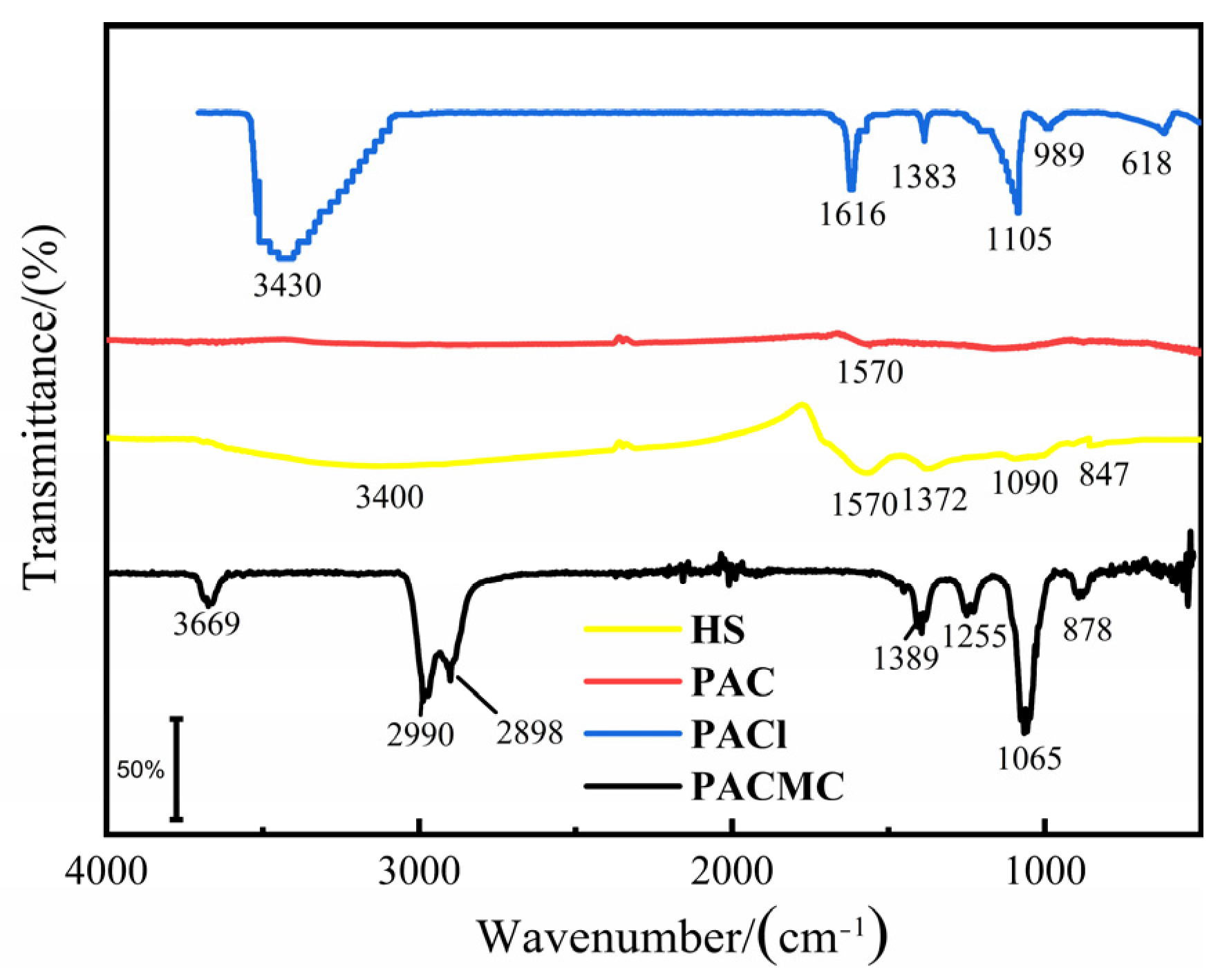
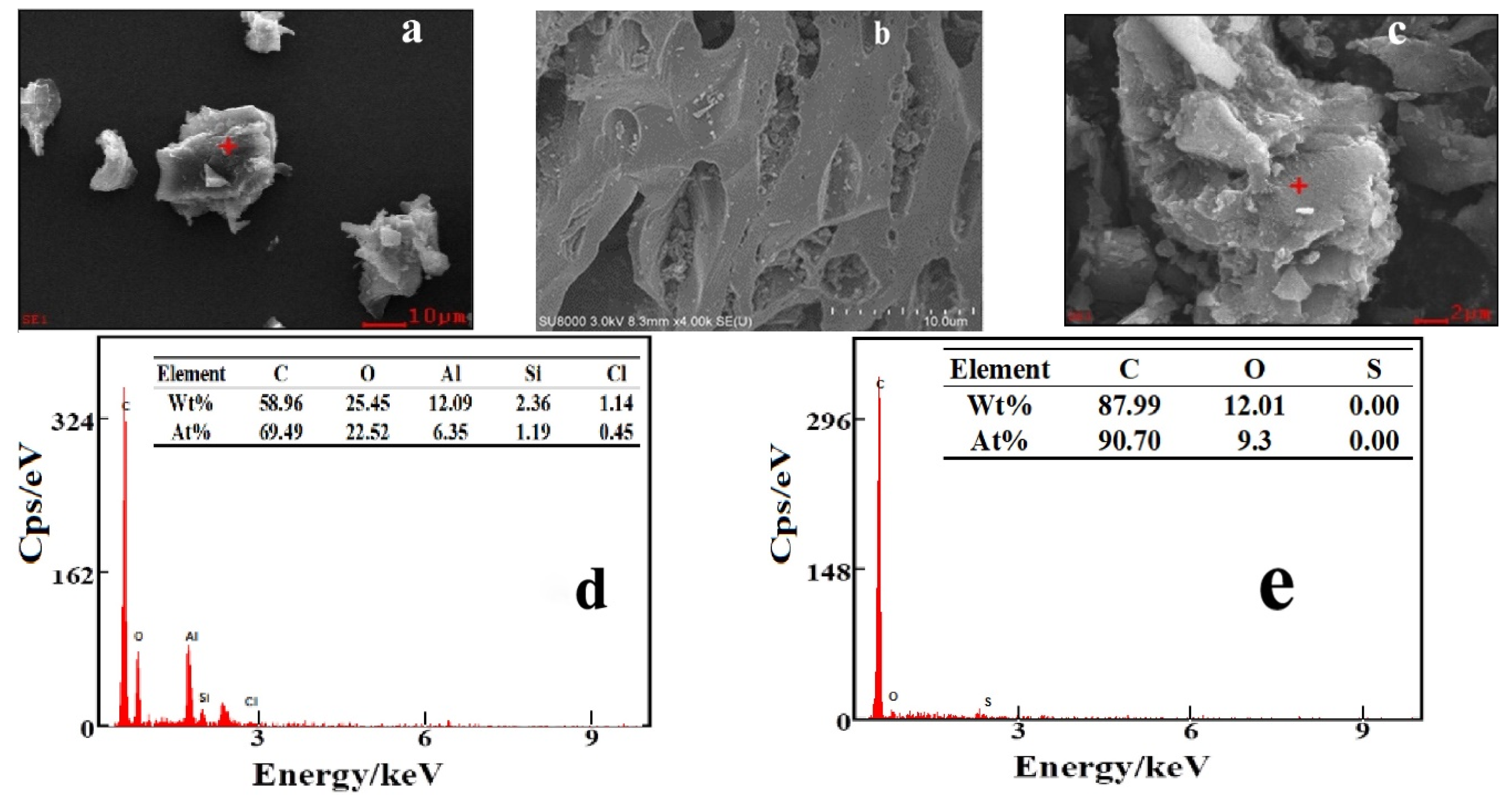
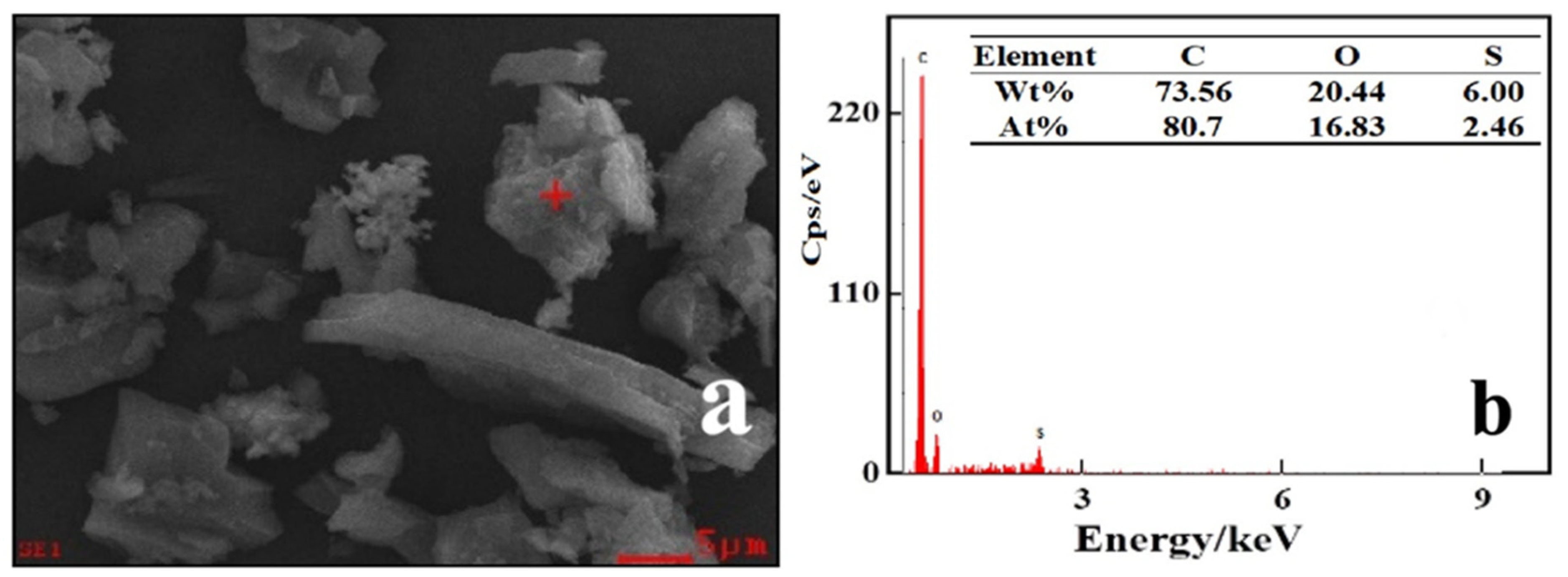

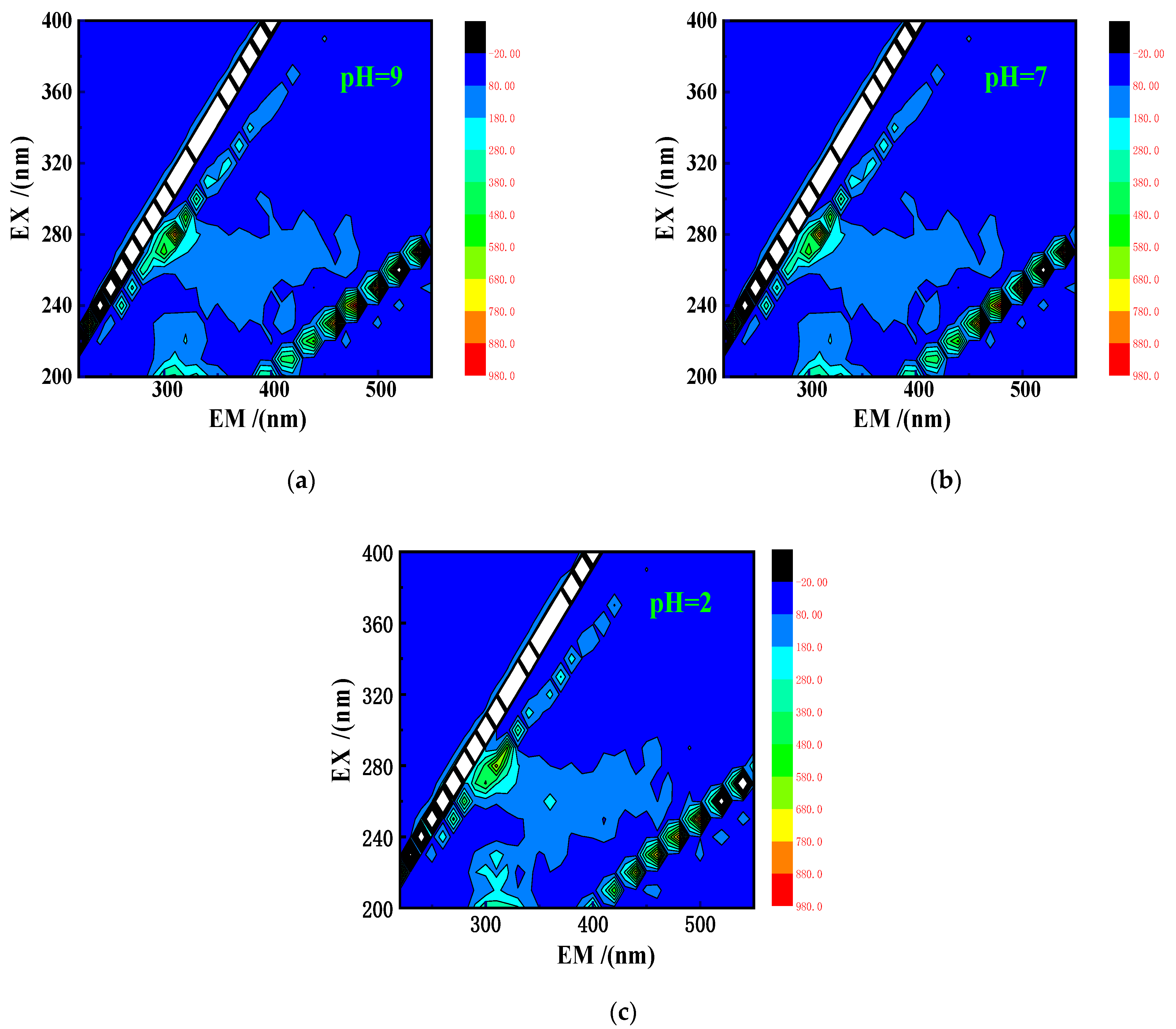
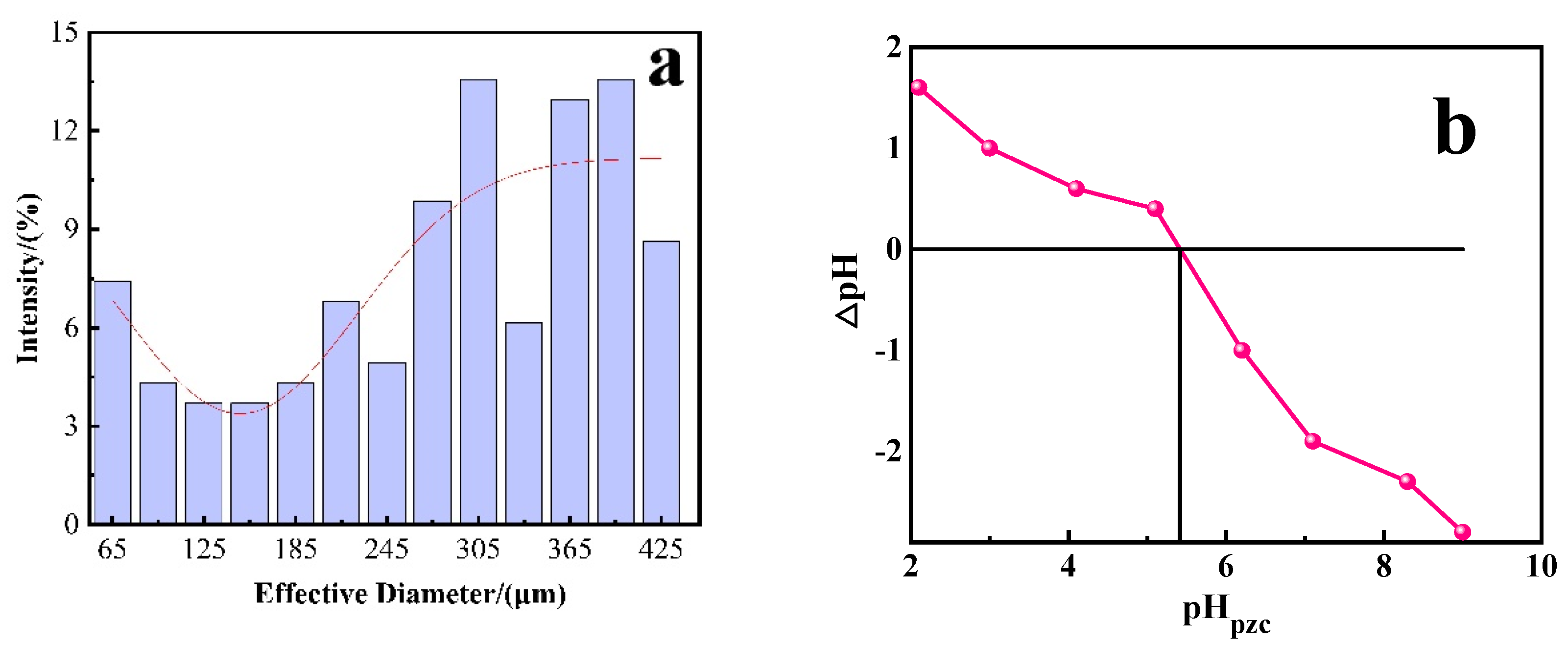

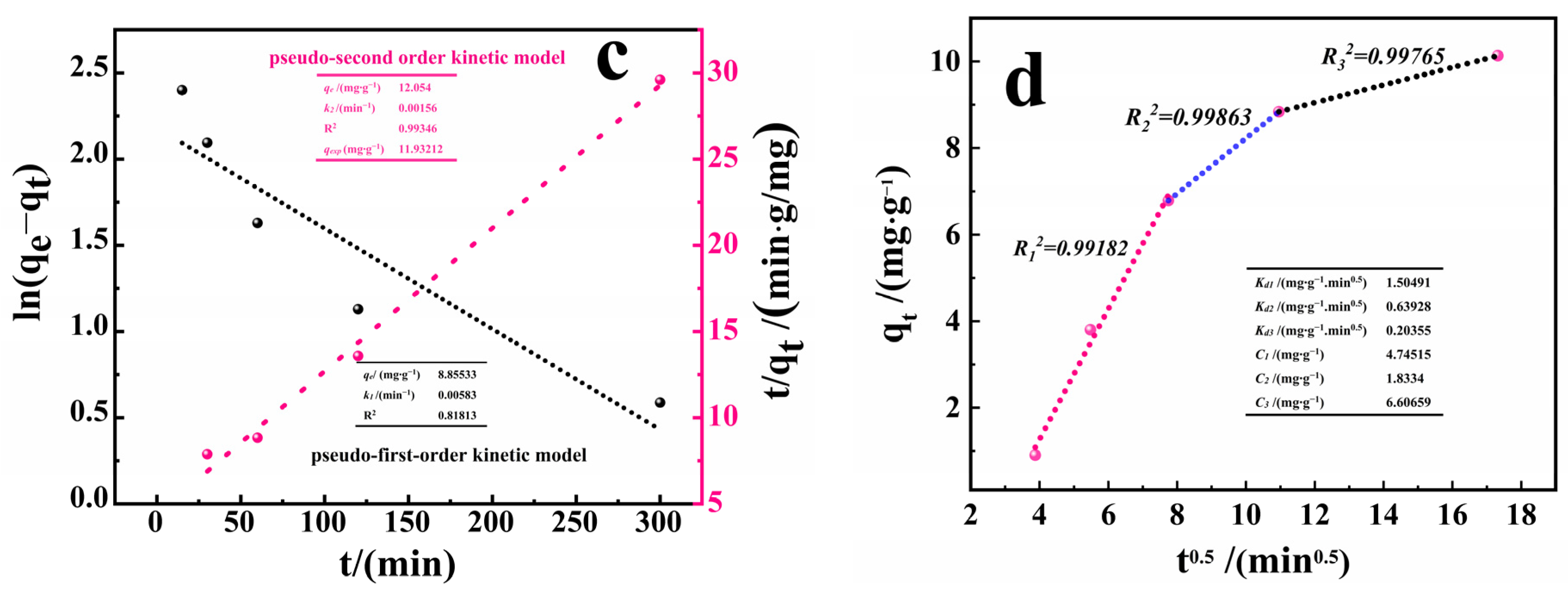
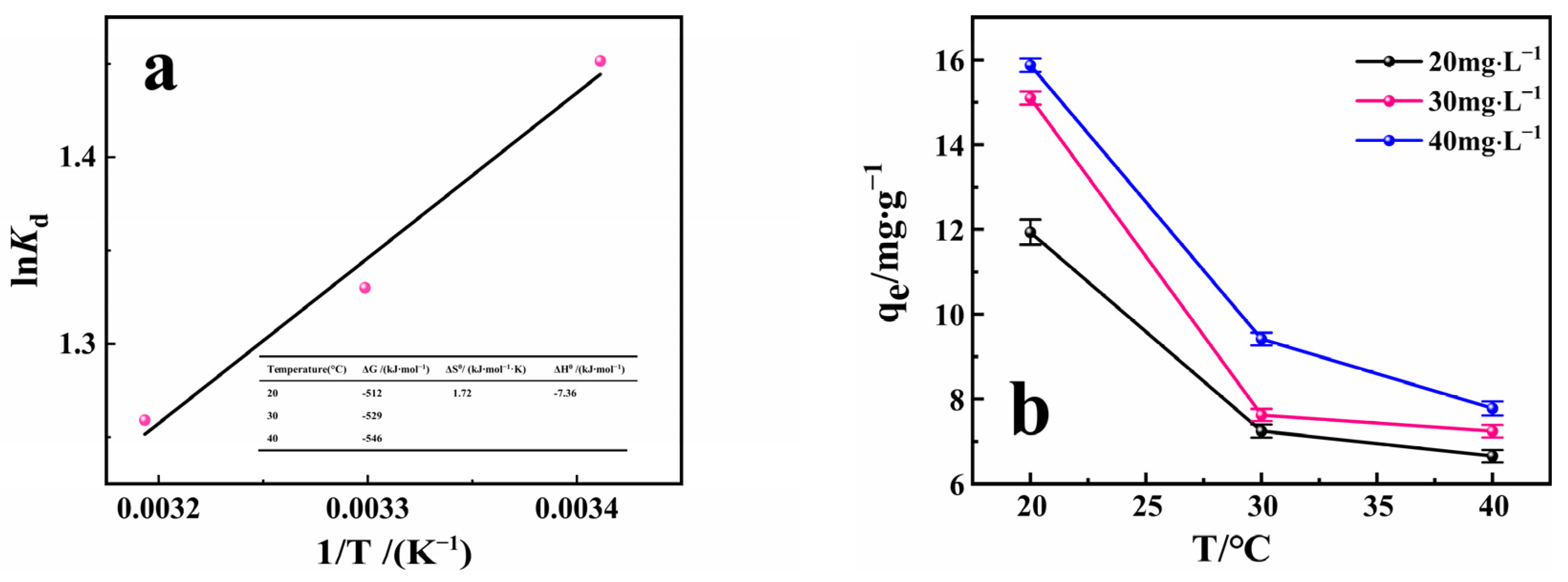
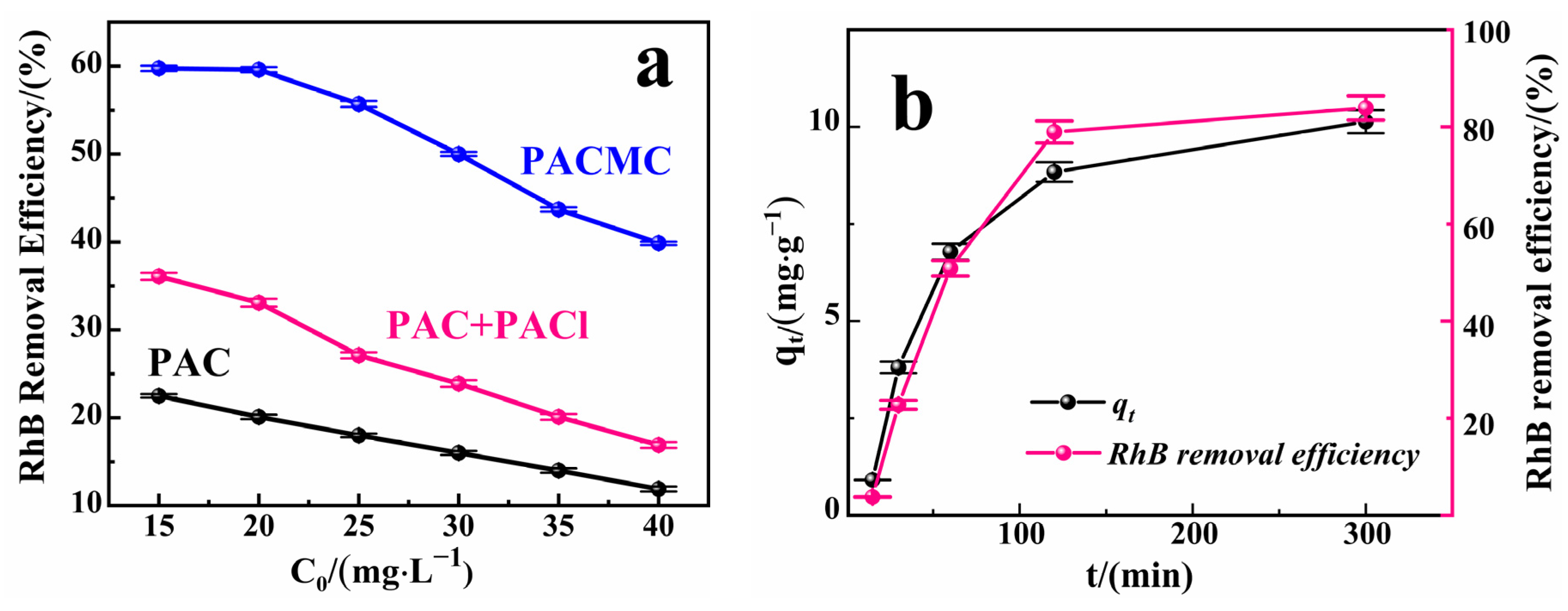


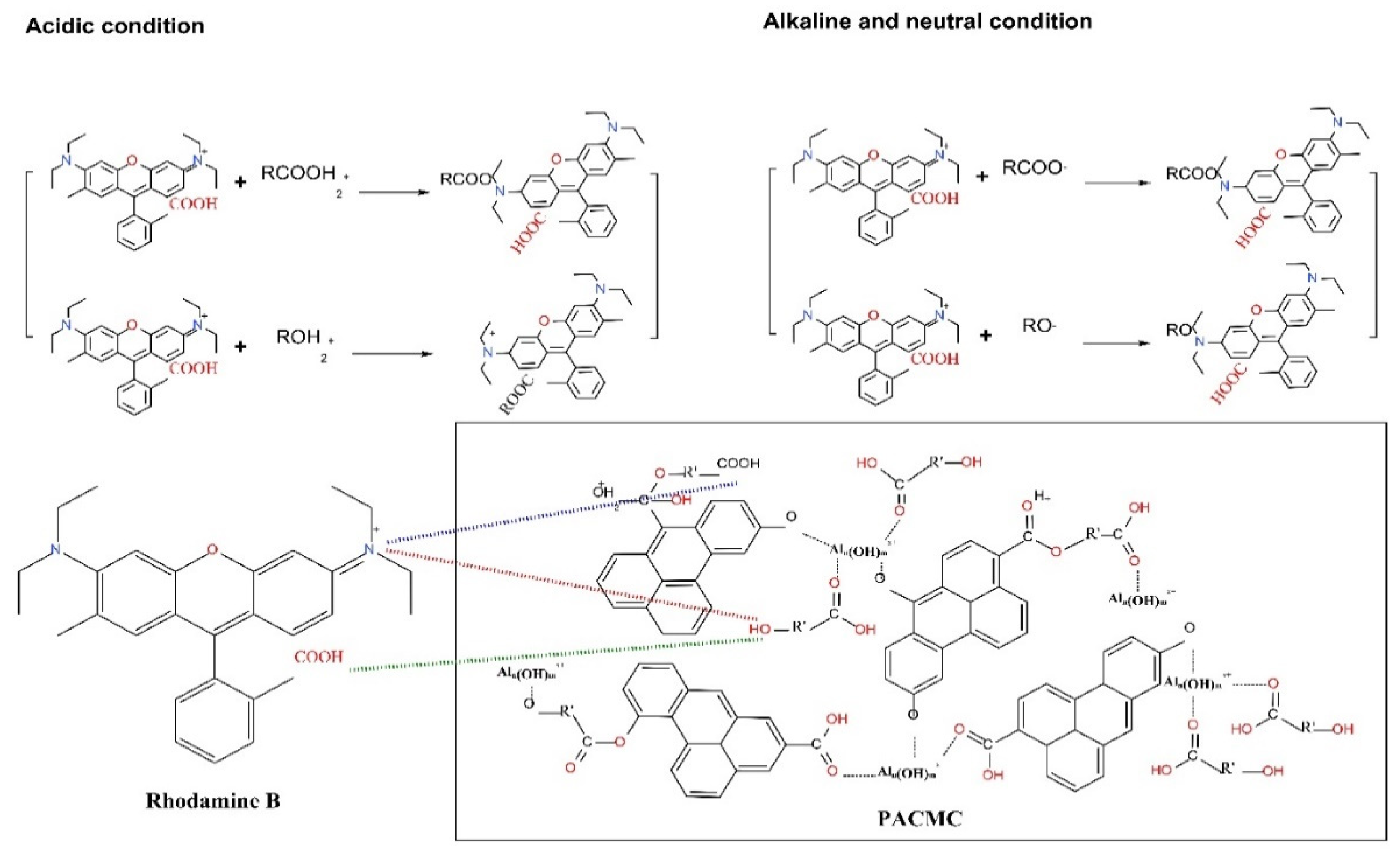
Publisher’s Note: MDPI stays neutral with regard to jurisdictional claims in published maps and institutional affiliations. |
© 2022 by the authors. Licensee MDPI, Basel, Switzerland. This article is an open access article distributed under the terms and conditions of the Creative Commons Attribution (CC BY) license (https://creativecommons.org/licenses/by/4.0/).
Share and Cite
Song, Y.; Wang, K.; Zhao, F.; Du, Z.; Zhong, B.; An, G. Preparation of Powdered Activated Carbon Composite Material and Its Adsorption Performance and Mechanisms for Removing RhB. Water 2022, 14, 3048. https://doi.org/10.3390/w14193048
Song Y, Wang K, Zhao F, Du Z, Zhong B, An G. Preparation of Powdered Activated Carbon Composite Material and Its Adsorption Performance and Mechanisms for Removing RhB. Water. 2022; 14(19):3048. https://doi.org/10.3390/w14193048
Chicago/Turabian StyleSong, Yarui, Kaisheng Wang, Fajun Zhao, Zhaoxi Du, Biao Zhong, and Guangyu An. 2022. "Preparation of Powdered Activated Carbon Composite Material and Its Adsorption Performance and Mechanisms for Removing RhB" Water 14, no. 19: 3048. https://doi.org/10.3390/w14193048
APA StyleSong, Y., Wang, K., Zhao, F., Du, Z., Zhong, B., & An, G. (2022). Preparation of Powdered Activated Carbon Composite Material and Its Adsorption Performance and Mechanisms for Removing RhB. Water, 14(19), 3048. https://doi.org/10.3390/w14193048




